Net-Zero Hero: Carmen Rangel

I’m helping to make Austin Net-Zero by transforming discarded materials into vibrant art and empowering community through creativity.
Meet our newest Net-Zero Hero: Carmen Rangel. Carmen is a community artist and co-founder of The Mosaic Workshop. The Mosaic Workshop teaches people of all ages the art of mosaic and leads the design and installation of monumental community-based mosaic murals. For their commitment to supporting a zero-waste future through material reuse, The Mosaic Workshop took home the 2024 grand finalist prize at the City of Austin’s Circular Austin Showcase. In 2024, they also became gold members of the Austin Green Business Leaders program, for their proven excellence across seven different sustainability-based categories. In her own art, Carmen weaves themes of the Latinx culture and experience, wanderlust, and inspiration from the natural world.
We met with Carmen at Holly Commons on East Cesar Chavez Street, where several mosaic murals from The Mosaic Workshop can be found, including their most recent project, “Under the Same Sun,” which was led by Carmen. We spoke with her about her commitment to reusable materials, her inspirations as an artist, and what role she thinks artists can play in the larger climate movement. Read on!
What inspired you to take action?
I’ve always been a creative spirit, drawn to the beauty and wonder of the world around me. I was very lucky to have an active childhood exploring the outdoors. These experiences sparked my passion for incorporating nature into my art — and this deep connection to the outdoors continues to shape my artistic journey.
About a decade ago, I started painting murals. As my career was growing, I became overwhelmed by the amount of waste and single-use materials. I started to notice the paint swatches accumulating as I picked my color palettes and the amount of roller naps used to prime the walls, among other things, but these were the ones that I started to explore within my art. I began creating collages with these materials that would otherwise be discarded. In 2019, I was introduced to the mosaic art form and quickly realized that it was essentially collage but with glass and tile. My friend and fellow muralist, J Muzacz, and I started The Mosaic Workshop to teach the art form and create community-led mosaic murals utilizing recycled and repurposed tiles that would otherwise become waste.
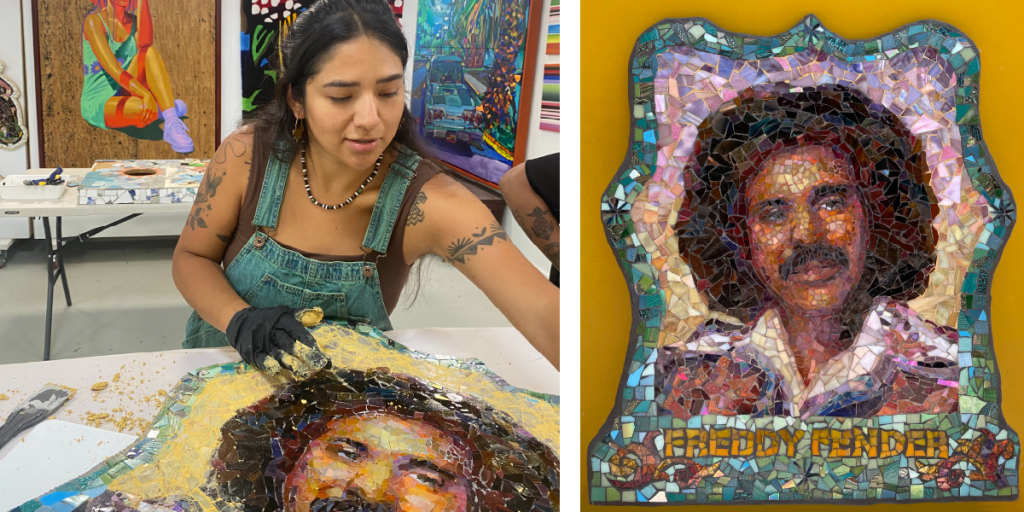
Left to right: Carmen works on a mosaic of Tejano singer-songwriter Freddy Fender in her studio (photo courtesy of Kate Storck); the finished mosaic. This mosaic is part of The Mosaic Workshop’s The Legends Project series, which honors cultural leaders.
How did you do it?
Researching and experimenting have been a big part of this journey. Soon after being introduced to mosaics, we started The Mosaic Workshop with some small grant funding and a passion for sharing the art form with others, but we were far from experts at the time. When you are exploring new creative endeavors, especially something so niche like mosaic, it can feel a bit intimidating or hard to find information. We noticed there was a need for accessible resources. Through research, I was exposed to mosaics created with a range of diverse materials, like glass bottles, stained glass, broken plates, mirrors, handmade ceramics, and the tiles and marble commonly used in homes. Around the same time, I had been creating collages with paint swatches that I accumulated from painting murals or that I got from Austin Creative Reuse. It felt like a natural transition and easy to adapt the same way of thinking to mosaic.
After launching, we naturally built a community and partnerships with workshop participants, artists, organizations, and businesses that have made it possible for us to do way more than teaching mosaic. We have had the opportunity to create impactful public art projects, all while diverting materials from becoming waste. Lots of our materials are donated to us. Our team sorts, organizes, and stores the pieces in our new studio in East Austin. We have now created over 1,500 square feet of mosaics made from 100% recycled materials.
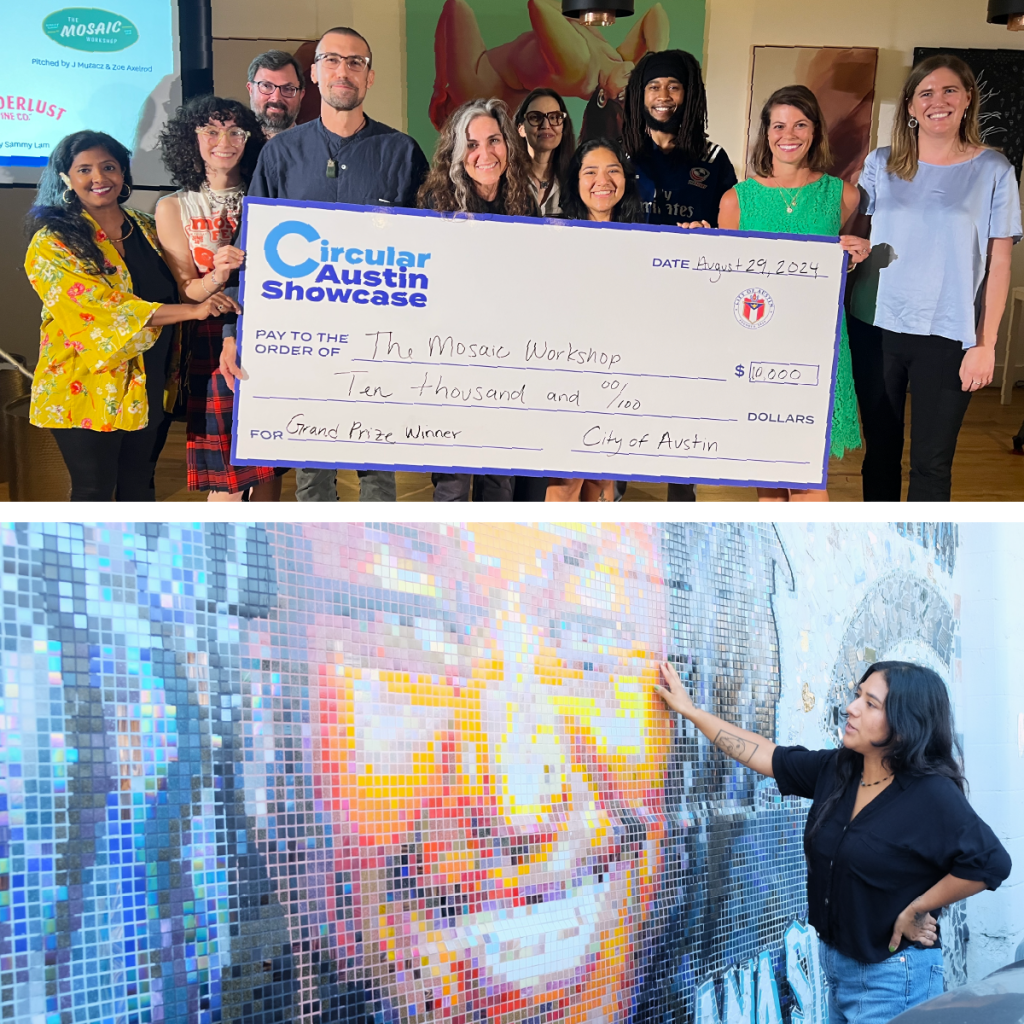
Top to bottom: Carmen, J, and other members of The Mosaic Workshop team accept the $10,000 grand finalist check from the Circular Austin Showcase; Carmen points out details on a gridded mosaic completed by The Mosaic Workshop.
I had the privilege of being the lead artist for our most recent community public art mosaic mural. Volunteers and I worked on the mosaic in the studio and onsite for a month. A large majority of this project was created with donated materials that I spent two days organizing into color palettes. The piece is called Under the Same Sun, and the inspiration for the design of this project came from wanting to create a moment of peace and calmness in a bustling area as if you were in nature. This piece honors the beauty and interconnectivity of nature — from flowers and plants with roots in the Earth to creatures that crawl upon the land and those that soar through the sky. The hummingbird is the centerpiece of the mosaic — a symbol of joy, resilience, and connection to the natural world.
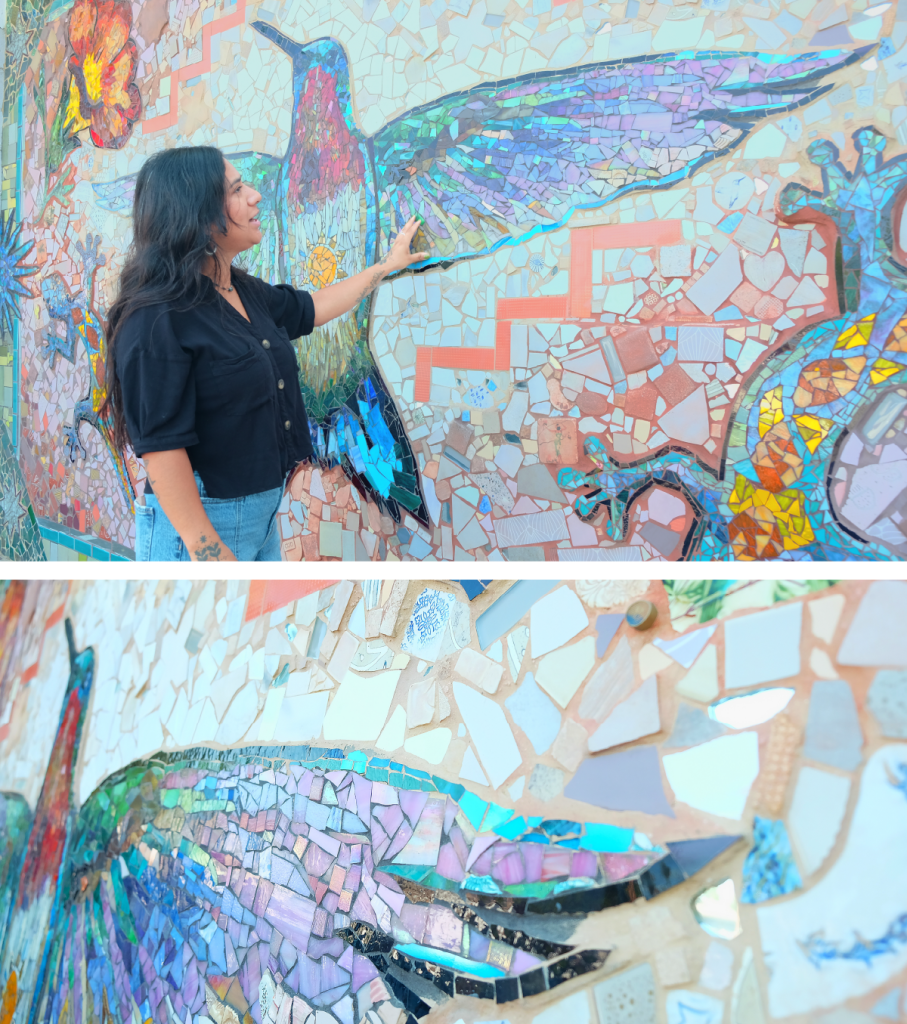
Top to bottom: Camen speaks about the iridescent tiles that made up the hummingbird’s wing in “Under the Same Sun,” The Mosaic Workshop’s most recent public art project, which was designed and led by Carmen; a detail of the hummingbird’s wing.
What’s been most rewarding about getting involved in this way?
The most rewarding part has been witnessing the impact of creating murals with our participants and seeing the materials be given a new life.
Completing these large-scale public art projects using recycled materials requires the help of many volunteers all learning different mosaic-making techniques. I see them learn and fall in love with the process the same way that I did. Our volunteers become really invested in the project, because it is as much theirs as it is mine. I see many people leave feeling accomplished when the artwork is complete. It is such a rare and unique opportunity in our society today to have intentional, inclusive, creative spaces like this that encourage the bond of making monuments together.
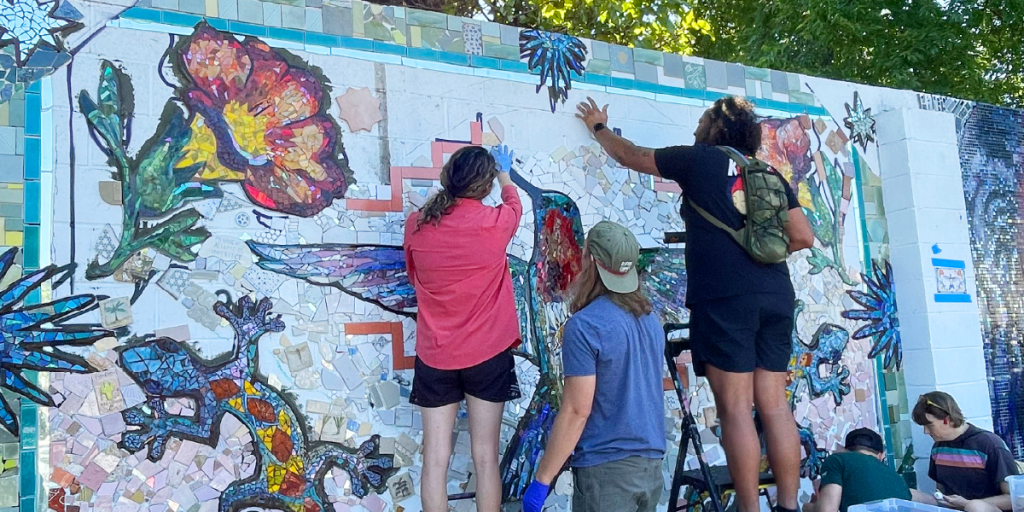 Volunteers work on installing the “Under the Same Sun” mosaic on a wall at Holly Commons. Photo courtesy of The Mosaic Workshop.
Volunteers work on installing the “Under the Same Sun” mosaic on a wall at Holly Commons. Photo courtesy of The Mosaic Workshop.
I love seeing how it sparks change — community members tell me that they have leftover tile from a home project or broken ceramics or plates that they were gonna throw away but now view them differently. They start brainstorming how they can utilize them in a creative way.
What’s been the toughest part?
The toughest part is the internal challenges I have with myself when choosing materials for my art projects while grappling with my desire to be eco-friendly and sustainable. It can be frustrating when the best options for achieving my vision aren’t environmentally conscious, for example, some types of paints and adhesives. This can lead to feelings of guilt and conflict — a constant tug-of-war between artistic expression and environmental responsibility. I have to remind myself that it’s okay and the intention is what matters.
There are several unique challenges for us at The Mosaic Workshop. The biggest hurdles to overcome are the lack of funding to support our projects, the limited storage for our donated materials, and the shortage of wall space to create our mosaic murals. Creating these beautiful public art mosaics takes a lot of labor — creating the art, facilitating volunteers, and organizing donated materials. Since mosaics are more permanent than a painted mural, it is difficult and time-consuming to source these walls that allow artists to have creative freedom with community and volunteer input.
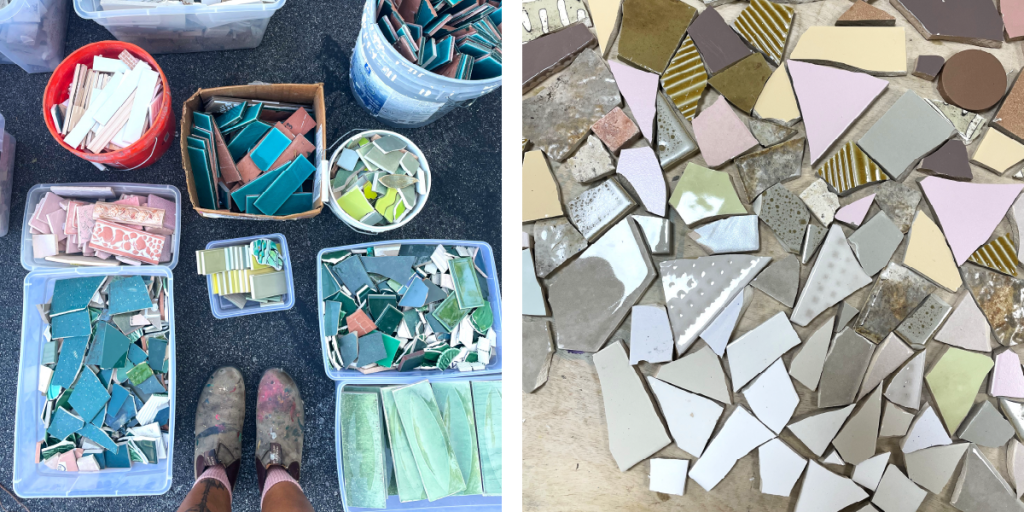
Left to right: Materials sorted by color at The Mosaic Workshop; a closeup of materials coming together for a section of “Under the Same Sun.” Photos courtesy of The Mosaic Workshop.
You’ve found ways to weave nature and sustainability into both The Mosaic Workshop and your own work as an artist. What role do you think artists can play in the environmental movement?
Almost ten years ago, I remember seeing powerful images of street art pieces protesting environmental issues in the community they were placed in. I was so moved by their impact and how they created a way for artists to communicate their message about a cause or idea. I was instantly inspired and from that moment, I wanted to see how I could combine my love for art and nature.
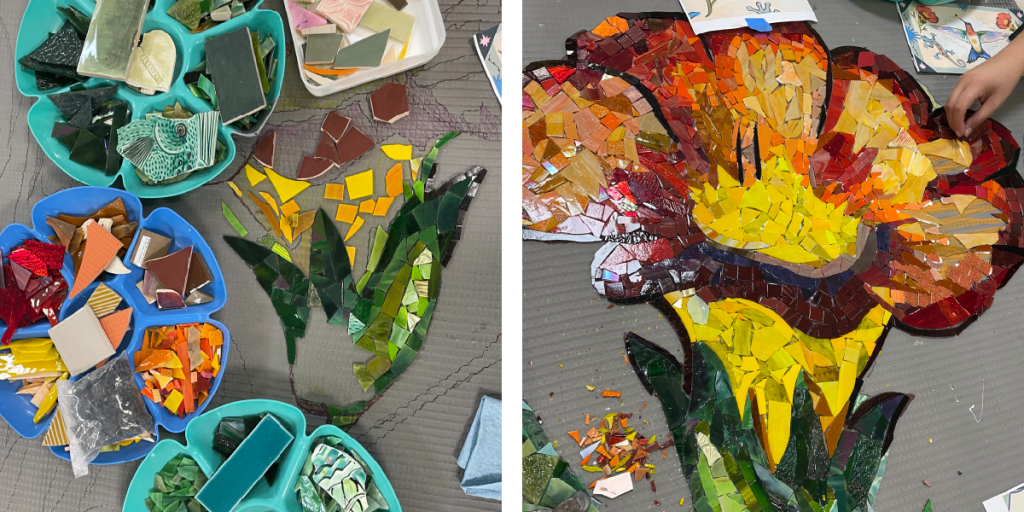
A flower takes shape in the studio for installation in the “Under the Same Sun” mosaic. Photos courtesy of The Mosaic Workshop.
I think that artists can play a large role in the environmental movement because communicating visually is sometimes more moving and impactful. Additionally, artists can lead by example, experimenting with sustainable practices and materials and encouraging others to consider eco-friendly choices.
What advice do you have for others?
Set aside time to explore your creativity just for the fun of it and for a mental health boost. When you focus on the journey rather than a perfect outcome, you give yourself the freedom to experiment, play, and discover new perspectives. Through the community mosaic mural projects I’ve facilitated with The Mosaic Workshop, I’ve learned that so many people are looking for creative outlets, whether or not they consider themselves artists. Seeing them leave feeling inspired and accomplished proves its benefits.
I also think we need to step back and change the way we look at materials as resources instead of disposable items. We should strive to make small changes whenever possible. Engage in mindful consumption and discard mindfully, as well. What one person views as waste can be given a new life through art.
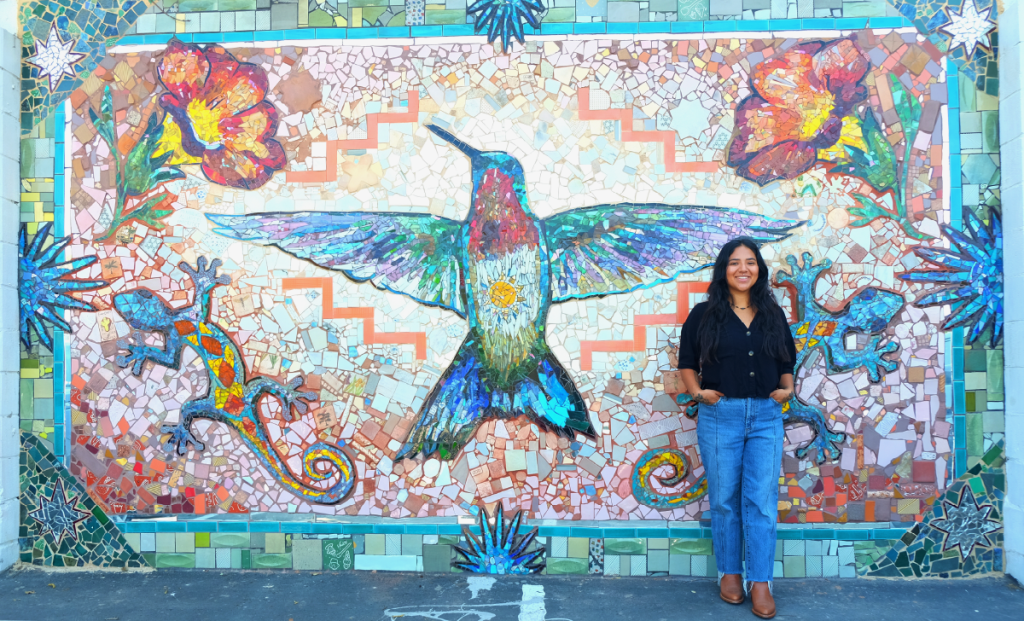
Austin is striving to be zero waste by 2040. Learn more about how you can contribute to this goal. To learn more about Austin's net-zero goal and explore actions you can take to support a greener community, view the Austin Climate Equity Plan.
Share your Net-Zero contributions with us on X (formerly Twitter) or Facebook, and use #NetZeroHero. If you know a Net-Zero Hero (or heroes!) who should be recognized for their efforts, send your nomination to sustainability@austintexas.gov.
